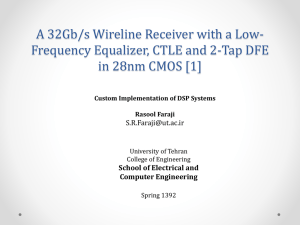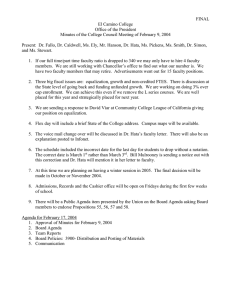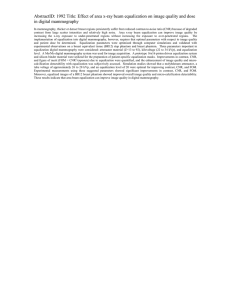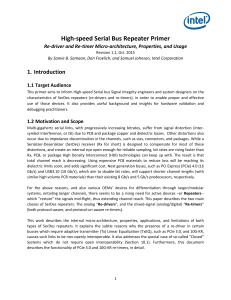Energy Efficient High-Speed Links Electrical and Optical
advertisement
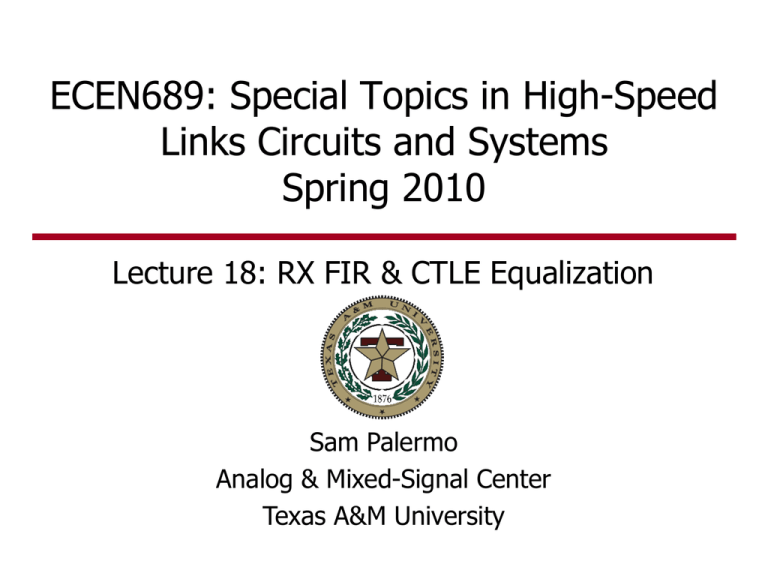
ECEN689: Special Topics in High-Speed Links Circuits and Systems Spring 2010 Lecture 18: RX FIR & CTLE Equalization Sam Palermo Analog & Mixed-Signal Center Texas A&M University Announcements • HW5 now due Friday (in class) • Any issues? • Reading • Hanumolu equalization overview paper 2 Agenda • RX FIR Equalization • RX CTLE Equalization 3 Link with Equalization TX FIR Equalization Σ TX Clk Generation (PLL) f Deserializer Channel Serializer DTX[N:0] RX CTLE + DFE Equalization DRX[N:0] RX Clk Recovery (CDR/Fwd Clk) 4 TX FIR Equalization • TX FIR filter pre-distorts transmitted pulse in order to invert channel distortion at the cost of attenuated transmit signal (de-emphasis) w-1 TX data z-1 w0 z-1 w1 z-1 w2 z-1 wn 5 RX FIR Equalization • Delay analog input signal and multiply by equalization coefficients • Pros • With sufficient dynamic range, can amplify high frequency content (rather than attenuate low frequencies) • Can cancel ISI in pre-cursor and beyond filter span • Filter tap coefficients can be adaptively tuned without any back-channel • Cons • Amplifies noise/crosstalk • Implementation of analog delays • Tap precision [Hall] 6 RX Equalization Noise Enhancement • Linear RX equalizers don’t discriminate between signal, noise, and cross-talk • While signal-to-distortion (ISI) ratio is improved, SNR remains unchanged [Hall] 7 Analog RX FIR Equalization Example • 5-tap equalizer with tap spacing of Tb/2 3rd-order delay cell 1Gb/s experimental results D. Hernandez-Garduno and J. Silva-Martinez, “A CMOS 1Gb/s 5-Tap Transversal Equalizer based on 3rd-Order Delay Cells," ISSCC, 2007. 8 Digital RX FIR Equalization • Digitize the input signal with high-speed low/medium resolution ADC and perform equalization in digital domain • Digital delays, multipliers, adders • Limited to ADC resolution • Power can be high due to very fast ADC [Hanumolu] 9 Digital RX FIR Equalization Example [Harwood ISSCC 2007] • 12.5GS/s 4.5-bit Flash ADC in 65nm CMOS • 2-tap FFE & 5-tap DFE • XCVR power (inc. TX) = 330mW, Analog = 245mW, Digital = 85mW 10 RX Continuous-Time Linear Equalizer (CTLE) • Passive R-C (or L) can implement high-pass transfer function to compensate for channel loss • Cancel both precursor and long-tail ISI • Can be purely passive or combined with an amplifier to provide gain Passive CTLE Active CTLE Vo+ [Hanumolu] Din- VoDin+ 11 Passive CTLE • Passive structures offer excellent linearity, but no gain at Nyquist frequency H (s ) = ωz = [Hanumolu] 1 + R1C1s R2 R1 + R2 1 + R1 R2 (C + C )s 1 2 R1 + R2 1 , R1C1 DC gain = Peaking = ωp = 1 R1 R2 (C1 + C2 ) R1 + R2 R2 C1 , HF gain = R1 + R2 C1 + C2 HF gain ω p R1 + R2 C1 = = DC gain ω z R2 C1 + C2 12 Active CTLE • Input amplifier with RC degeneration can provide frequency peaking with gain at Nyquist frequency • Potentially limited by gainbandwidth of amplifier • Amplifier must be designed for input linear range • Often TX eq. provides some low frequency attenuation • Sensitive to PVT variations and can be hard to tune • Generally limited to 1st-order compensation [Gondi JSSC 2007] 1 g RS CS H (s ) = m C p 1 + g m RS 2 1 s + s + RS CS RD C p 1 + g m RS 2 1 1 , ωp1 = , ωp2 = ωz = RS CS RS CS RD C p s+ DC gain = g m RD , Ideal peak gain = g m RD 1 + g m RS 2 Ideal Peaking = Ideal peak gain ω p1 = = 1 + g m RS 2 DC gain ωz 13 Active CTLE Example Vo+ Din- VoDin+ 14 Active CTLE Tuning • Tune degeneration resistor and capacitor to adjust zero frequency and 1st pole which sets peaking and DC gain CS ωz = 1 + g m RS 2 1 , ωp1 = RS CS RS CS RS 15 Next Time • RX DFE • Alternate/Future Approaches 16


